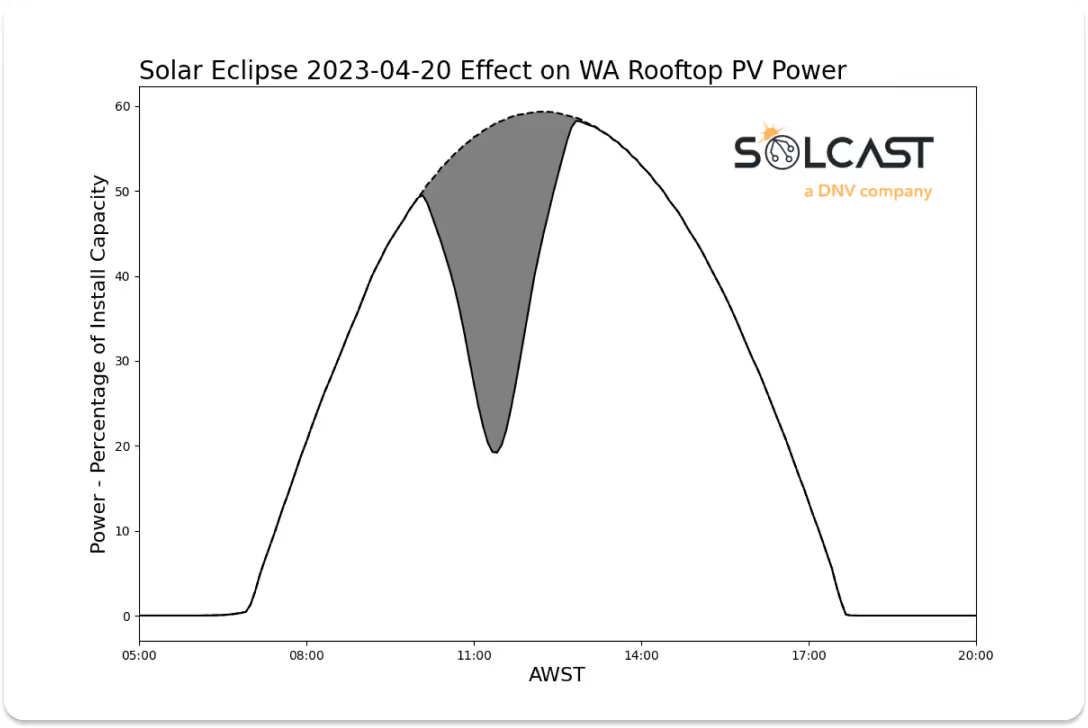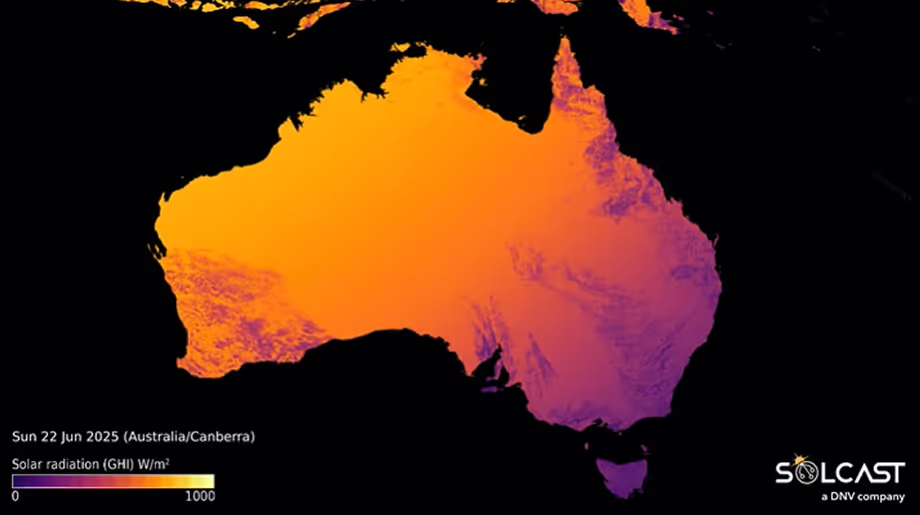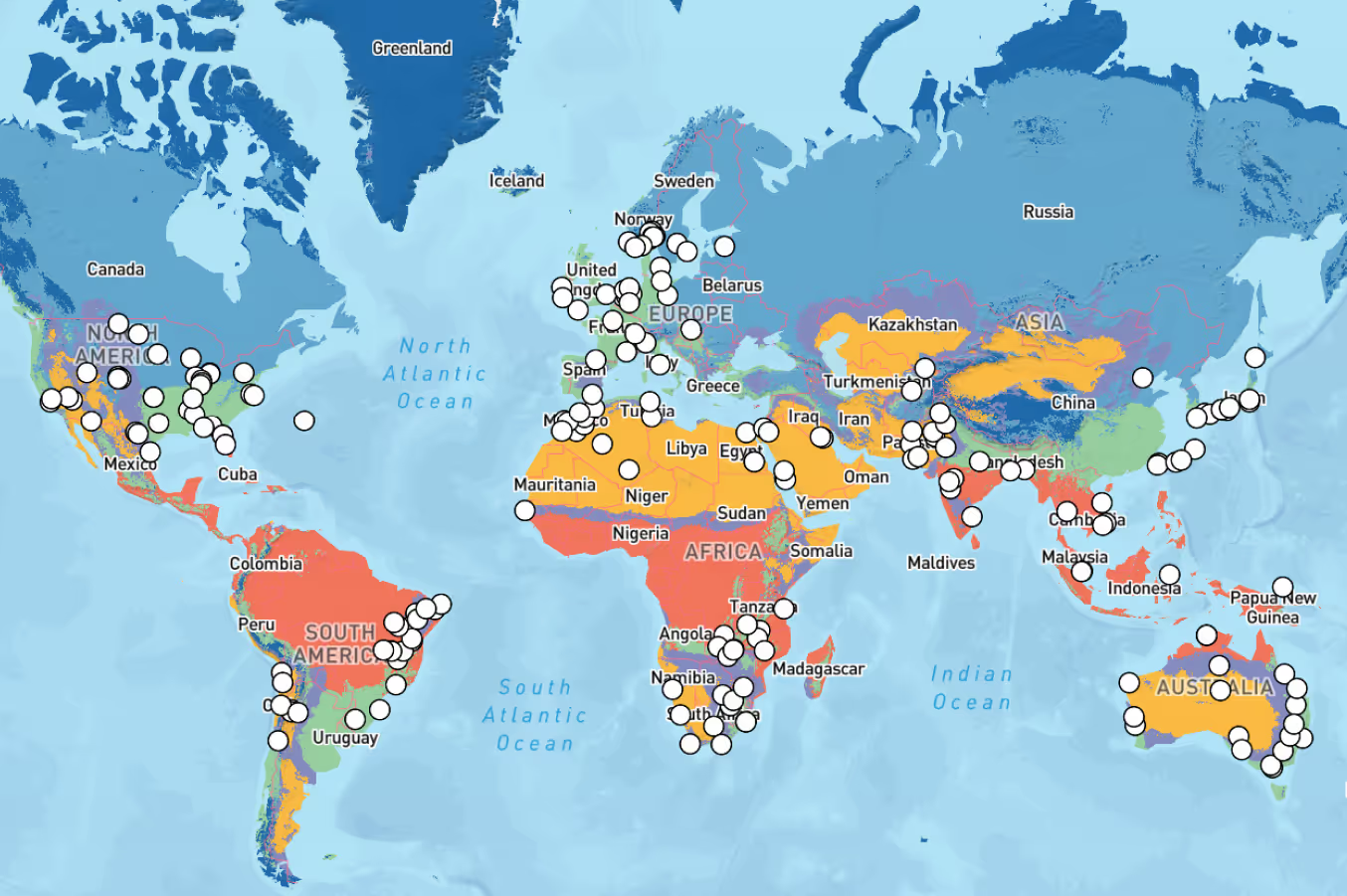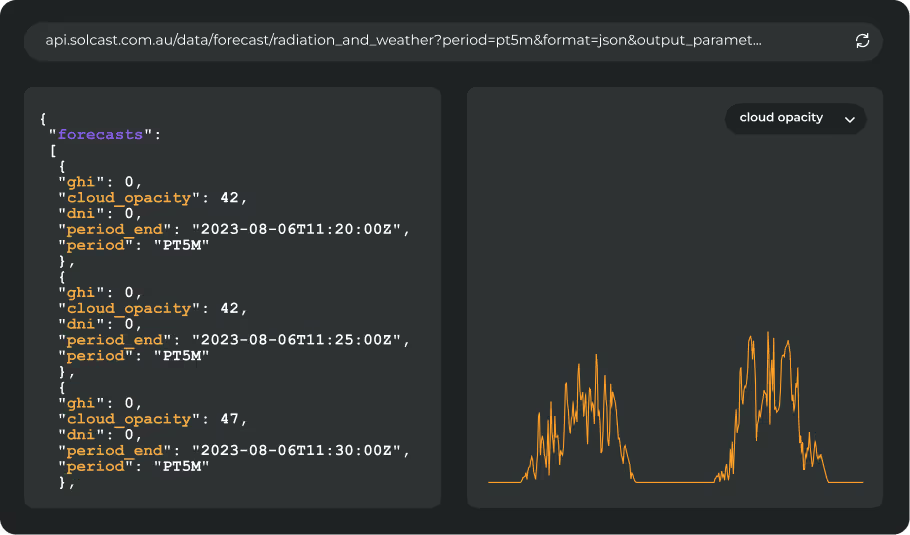On Thursday April 20, 2023, Australia and parts of South East Asia will witness a remarkable and unique solar eclipse, capturing the attention of solar and weather enthusiasts alike. This week’s event is a hybrid solar eclipse, which is a rare type of eclipse that transitions between an annular and a total solar eclipse as it moves along its path. The eclipse will be visible as a total solar eclipse in some areas, while others will experience an annular solar eclipse, where the Moon does not completely cover the Sun, leaving a visible "ring of fire."
At Solcast, we share the excitement around this rare phenomenon, not only is it an awesome demonstration of the scale of celestial bodies, but it also impacts irradiance for the day! In this blog post, we'll delve into the science behind hybrid solar eclipses, explain how our team has utilized cutting-edge techniques to model the event's impact on solar irradiance, and discuss the implications for the Western Australia power grid.
How solar eclipses impact irradiance
Solar eclipses occur when the Moon passes between the Earth and the Sun, temporarily obscuring a portion of the Sun's light. During an eclipse, the incident extraterrestrial irradiance—solar radiation originating outside the Earth's atmosphere—is reduced proportionally to the percentage of the Sun obscured by the Moon. This reduced extraterrestrial irradiance is then attenuated as it passes through the atmosphere and clouds, meaning less solar power reaches the Earth's surface during the eclipse.
The relationship between solar eclipses and irradiance is simple, until you introduce atmospheric conditions and calculations. To accurately translate extra terrestrial radiation to surface irradiance involves calculating the zenith and azimuth, atmospheric conditions, cloud, and the location of the observer or the asset. Accurate modelling of these factors is crucial for understanding the impact of an eclipse on solar energy production and weather patterns.
What’s the modelling approach to this problem?
To accurately model the effects of a solar eclipse on irradiance, we first determine the portion of the Sun that will be obscured. We do this by tracking the relative position of both astronomical objects from the perspective of an observer at a specific location and then calculating their overlap. Tracking the location of two celestial bodies for every single query would take some significant compute, so we have limited our calculations to only the time period and locations affected by the eclipse. That way we can maintain fast query speeds for all our customers.
This approach requires a model that can compute the position and movement of the Sun and Moon relative to an observer’s latitude and longitude. These algorithms take into account various astronomical factors, such as the obliquity of the ecliptic, the eccentricity of the Earth's orbit, and the precession of the equinoxes. Rather than rebuild this model, our team have used an open-source software package called PyEphem, developed by Brandon Rhodes, to track the relative location of the Sun and Moon. We would like to express our gratitude to Brandon for his invaluable contribution to the field. PyEphem allows us to accurately calculate the position of celestial bodies in the sky, taking into account various astronomical phenomena such as nutation, aberration, and atmospheric refraction.
Adding cloud cover at atmospheric conditions
In addition to the direct impact of the eclipse on extraterrestrial irradiance, cloud cover and atmospheric conditions play a significant role in determining the overall effect on solar irradiance. Solcast's satellite cloud tracking system is designed to accurately estimate cloud cover and its impact on irradiance, providing a comprehensive understanding of the eclipse's effect on solar energy production.
Our cloud tracking system uses data from multiple satellites to monitor cloud cover in real-time, enabling us to make precise predictions about the effect of clouds on solar irradiance during the eclipse. This information is combined with our eclipse irradiance modelling to provide a complete picture of the event's impact on solar energy production.
To focus on the impact of the eclipse, we’ve mapped this against a clear sky model, but any forecast requested through our API for these locations includes cloud forecasts. On the day of the eclipse, our regular satellite cloud tracking models will produce locally accurate cloud nowcasts that combine with the reduced clear-sky irradiance to accurately predict actual irradiance for everywhere impacted by the eclipse. Fortunately for eclipse enthusiasts, the current forecast is anticipating a relatively clear day across much of Western Australia.
Will the eclipse impact the power grid?
The solar eclipse's effect on irradiance will undoubtedly impact solar power generation, especially in Western Australia. As solar generation decreases proportionate to irradiance impacts during the eclipse, power grids will need to compensate for this temporary shortfall. Understanding and accurately predicting the extent of this impact is crucial for energy providers and grid operators to maintain stability and reliability in the power supply. We’ve already had Solcast customers reaching out asking for the impact on grid scale generation.

The above graph shows Solcast’s ‘behind the meter’ model of WA residential rooftop PV, and the impact of the eclipse impacted irradiance compared to a regular clearsky day. The total impact of the eclipse across the WA power grid (the grey shaded area) represents 12.25% of the expected rooftop generation.
This decrease in solar generation during the eclipse will require grid operators, asset operators and energy providers to prepare for the additional load on conventional power plants or energy storage systems. Accurate predictions of the eclipse's impact on solar irradiance can help these stakeholders optimise their energy management strategies and minimise any potential disruptions in power supply.
The temporary reduction in solar power generation highlights the importance of having a diverse energy mix and robust energy storage solutions. By integrating various sources of renewable energy, such as wind and hydro, along with energy storage systems, grid operators can ensure a reliable and stable power supply during events like solar eclipses. Accurate forecasts for decreases in irradiance, whether from weather or from celestial interference like during an eclipse, is essential to storage system operators so they can understand the expected pipeline of energy from solar assets.
Conclusion
At Solcast, we are passionate about solar and meteorological phenomena, and applying the eclipse model to our irradiance calculations has been an exciting and rewarding endeavor. Our team has been able to combine their expertise in satellite cloud tracking, irradiance modelling, and astronomical calculations to create a comprehensive and accurate representation of the solar eclipse's impact on irradiance.
The upcoming solar eclipse is not only an awe-inspiring celestial event but also an important event for solar power generators. Eclipses are relatively rare, and very predictable, but highlight the need for an accurate and detailed solar specific forecast. Solar operators need to able to accurately forecast their expected generation, and as you can see, it takes some complicated science and modelling to create those forecasts.
If you’re looking for a simple API that provides detailed and accurate solar data, we invite you to explore our services for more insights and data on this fascinating phenomenon.










.avif)


